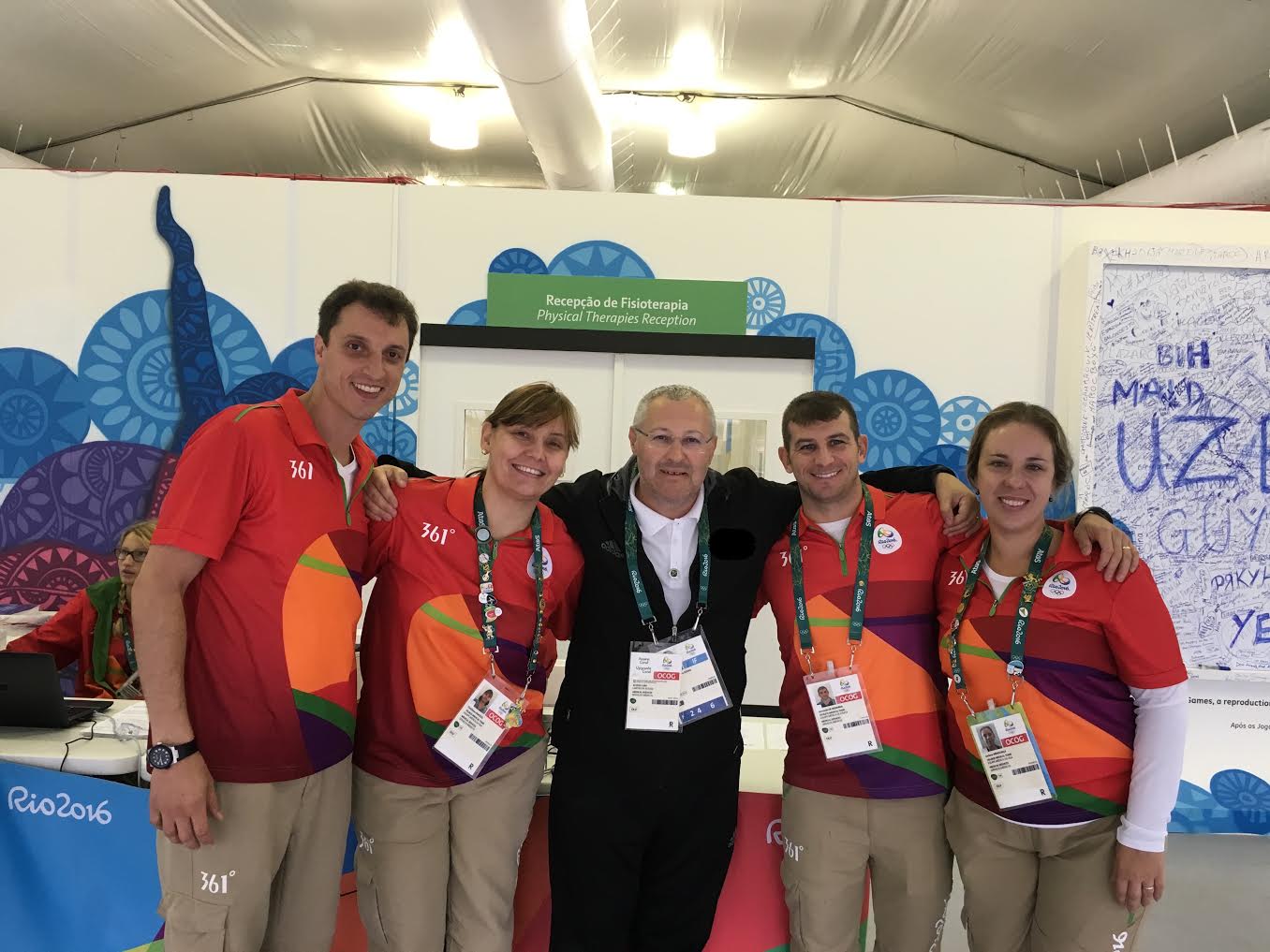By Mario Bizzini (@SportfisioSwiss)
On August 12th, I visited the Polyclinic at the Olympic Village, to meet my Brazilian Sports PT friends Felipe Tadiello and Luciana de Michelis (the current president of Sport Physical Therapy Group in Brasil – SONAFE> www.sonafe.com.br). The purpose of my visit was, on behalf of the International Federation of Sports Physical Therapy (IFSPT; www.ifspt.org), to officially welcome SONAFE as IFSPT Member Organization, whose application was accepted few weeks prior to the start of the Olympic Games in Rio de Janeiro.
Strong leadership
Felipe Tadiello led the organization of the sports physiotherapy at the Polyclinic of Rio 2016. He tactfully managed more than 800 physiotherapists (the majority were from Brasil, Argentina, Chile; 15% were international). This 800 included those sports PTs working at the training and competition (stadiums, training facilities) and those available in case of emergencies or extra support (medical responders).
Dedicated team

All PTs were volunteers, and underwent a rigorous selection process: in total there were almost 3000 interested Brazilians sports PTs who participated at several “pre-olympic” educational courses (organized by SONAFE) across Brazil. SONAFE, the largest sports PT association in South America, thank to the work and dedication of its leaders, has really raised the bar in providing quality education to its members. This process followed the recommendations by Phillips et al, a milestone publication on the preparations for the London 2012 Games (1). According to Luciana (the other important driving force within SONAFE) and Felipe, these 2 years of intensive preparation work toward the Olympics (the story was also featured on the WCPT website http://www.wcpt.org/news/brazil-olympics-August16) and the RIO 2016 experience represent an important legacy for the future of Brazilian sports PT!
Polyclinic services
At the Polyclinic different treatment options were offered to the athletes (from all nations, not only for those nations arriving without their own medical team): sports physiotherapy, electrotherapy, sports massage, cold water immersion, acupuncture, chiropractic, osteopathy, and a department for insoles and braces.
Here’s an example of a working day (August 11) at the Polyclinic: 72 athletes were treated by sports PTs, 62 received sports massage, 22 were seen by osteopaths, 15 by chiropractors and 108 (!) did cold water immersions. Those are some impressive figures underlying the role of sports physiotherapy at the Olympic Games (2), considering that many national teams were present in Rio with their own medical and physio staff.
All illnesses and physical problems, injuries (and subsequently treatments) were systematically recorded in a special online system, which was monitored by Felipe Tadiello and Mary Elaine Grant (Dublin, IOC Physiotherapy responsible). This was part of the comprehensive IOC injury documentation system (Injury Surveillance System) at the Olympic Games, coordinated by a research group with Lars Engebretsen and Roald Bahr (IOC Research and Oslo Sports Trauma & Research Center).
A model of national advancement
Higher quality sports PT means also better protection of health of the athletes, which is also one of the major objectives of the IOC (Engebretsen, Steffen 2015). The leadership of SONAFE before and at RIO 2016 sets an example for those countries hosting future Olympic Games (i.e. Japan in 2020), in terms of preparation and education following international guidelines and through international cooperation. Knowing the mentality and peculiarity of South American physiotherapy (often “isolated” within Portuguese- and Spanish-speaking world), one can only applaud the significant development of SONAFE towards a truly international organization, which will certainly benefit all the sports PTs in Latin America. IFSPT and BJSM have already and will continue to further support and promote sports physiotherapy worldwide, with the ultimate goal to continuously improve athlete’s health globally.
References
- Using criteria-based interview models for assessing clinical expertise to select physiotherapists at major multisport games. Phillips N, Grant ME, Booth L, Glasgow P. Br J Sports Med. 2015 Mar;49(5):312-7. doi: 10.1136/bjsports-2014-094176. Epub 2015 Jan 6.
- The role of sports physiotherapy at the London 2012 Olympic Games. Grant ME, Steffen K, Glasgow P, Phillips N, Booth L, Galligan M. Br J Sports Med. 2014 Jan;48(1):63-70. doi: 10.1136/bjsports-2013-093169.
- Protection of the elite athlete is the responsibility of all of us in sports medicine. Engebretsen L, Steffen K. Br J Sports Med. 2015 Sep;49(17):1089-90. doi: 10.1136/bjsports-2015-095221.
*************************************
Mario Bizzini, PhD, MSc, PT is as a research associate at the Schulthess Clinic in Zürich, Switzerland. He works there for the FIFA Medical Research and Assessment Center (F-MARC), the Swiss Concussion Center and the Human Performance Lab. His research interests focus on prevention and rehabilitation of sports injuries.
Mario is BJSM Deputy Editor, a reviewer for various scientific journals, and also a specialist in sports physiotherapy (committee member of the Swiss and of the International Federation of Sports Physical Therapy).